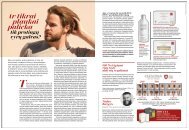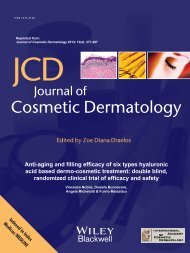CRESCINA produktų efektyvumą įrodantys in-vivo tyrimai
Create successful ePaper yourself
Turn your PDF publications into a flip-book with our unique Google optimized e-Paper software.
Dermatol Ther (Heidelb)<br />
It is characterized by progressive th<strong>in</strong>n<strong>in</strong>g of<br />
the scalp hairs, def<strong>in</strong>ed by various patterns<br />
[2], which can start at any age after puberty<br />
and is potentially reversible. Even if from a<br />
medical po<strong>in</strong>t of view, AGA is considered a<br />
relatively mild condition; however, people<br />
suffer<strong>in</strong>g from this condition consider AGA a<br />
serious condition that impacts their selfesteem,<br />
well-be<strong>in</strong>g, social relationships, and<br />
confidence.<br />
The ma<strong>in</strong> factors underl<strong>in</strong>g hair loss <strong>in</strong> AGA<br />
are genetic predisposition and <strong>in</strong>creased<br />
sensitivity of the hair follicles to androgens<br />
[3]. AGA is often precipitated and exacerbated<br />
by conditions that can <strong>in</strong>duce telogen<br />
effluvium, <strong>in</strong>clud<strong>in</strong>g drugs, acute stressors, and<br />
weight loss [4]. However, <strong>in</strong> recent years it<br />
has been shown that other factors, such<br />
as micro<strong>in</strong>flammation [5], decreased<br />
microcirculation [6], and ag<strong>in</strong>g [7], can cause<br />
hair loss <strong>in</strong> AGA. These changes contribute to<br />
shift<strong>in</strong>g the normal balance of the hair cycle<br />
lead<strong>in</strong>g to a shorten<strong>in</strong>g of the anagen phase.<br />
The major components of bald<strong>in</strong>g <strong>in</strong> AGA are<br />
frontotemporal recession and loss of hair over<br />
the vertex. Hairs become shorter and f<strong>in</strong>er, and<br />
f<strong>in</strong>ally complete hair loss occurs except at the<br />
lateral and posterior marg<strong>in</strong>s of scalp, where<br />
hair is reta<strong>in</strong>ed.<br />
Histologically, <strong>in</strong> AGA large term<strong>in</strong>al follicles<br />
dim<strong>in</strong>ish <strong>in</strong> size dur<strong>in</strong>g hair cycles, and the<br />
result<strong>in</strong>g m<strong>in</strong>iaturized follicle eventually<br />
produces a microscopic hair. Testosterone is<br />
necessary for m<strong>in</strong>iaturization, and 5-alphareductase<br />
<strong>in</strong>hibitors, which block the<br />
conversion of testosterone to its more active<br />
form dihydrotestosterone (DHT), delay the<br />
progression of AGA [8]. Recently, Garza and<br />
coworkers [9] reported the preservation of stem<br />
cell population and a decreased conversion of<br />
hair follicle stem cells to progenitor cells <strong>in</strong> bald<br />
scalp biopsies from AGA <strong>in</strong>dividuals. This<br />
f<strong>in</strong>d<strong>in</strong>g is consistent with the current cl<strong>in</strong>ical<br />
concept that AGA is a nonscarr<strong>in</strong>g type of<br />
alopecia and suggests potential reversibility of<br />
the condition.<br />
Currently, only two medications, based on<br />
f<strong>in</strong>asteride and m<strong>in</strong>oxidil as active<br />
pharmacological <strong>in</strong>gredients, are approved by<br />
the US Food and Drug Adm<strong>in</strong>istration (FDA) for<br />
AGA treatment. However, they are costly, require<br />
lifelong treatment, and may have side effects.<br />
Furthermore, people are frequently reluctant/<br />
<strong>in</strong>timidated by the pharmacological approach<br />
to treat a disease that is not life threaten<strong>in</strong>g. Thus,<br />
a topical, nonpharmacological, effective<br />
cosmetic treatment could be more acceptable to<br />
patients.<br />
The aim of the present study was to assess<br />
the efficacy of the use of a patented (US<br />
6,479,059 B2 and CH 703 390), topical<br />
cosmetic product, Cresc<strong>in</strong>a Ò HFSC (human<br />
follicle stem cell; Labo Cosprophar AG, Basel,<br />
Switzerland), claimed to be effective for the<br />
treatment of male AGA [10]. The active<br />
<strong>in</strong>gredients conta<strong>in</strong>ed <strong>in</strong> the product were<br />
chosen to obta<strong>in</strong> three ma<strong>in</strong> effects:<br />
proliferation of the stem cells of both the<br />
bulge and the dermal papilla, kerat<strong>in</strong>ization,<br />
and stimulation of microcirculation. Stem cell<br />
and dermal papilla stem cell proliferation was<br />
achieved by hydrolyzed rice prote<strong>in</strong> and<br />
corosolic acid, respectively. Kerat<strong>in</strong>ization was<br />
stimulated by cyste<strong>in</strong>e, lys<strong>in</strong>e, and a<br />
glycoprote<strong>in</strong> (lect<strong>in</strong>). Microcirculation was<br />
stimulated by benzyl nicot<strong>in</strong>ate. The<br />
mentioned results were obta<strong>in</strong>ed from studies<br />
commissioned by the company Labo<br />
Cosprophar AG, which has filed a patent (CH<br />
703 390 B1) [10].<br />
123






